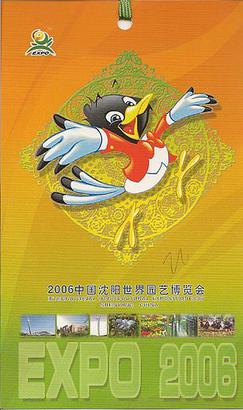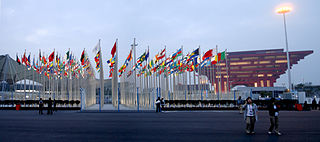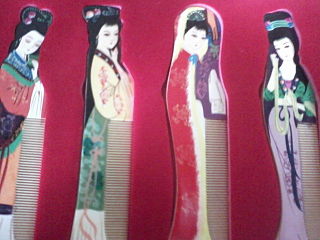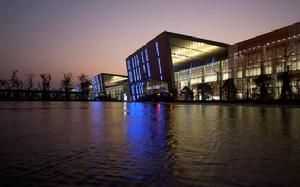
Expo 2010, officially the Expo 2010 Shanghai China, was held on both banks of the Huangpu River in Shanghai, China, from 1 May to 31 October 2010. It was a major World Expo registered by the Bureau International des Expositions (BIE), in the tradition of international fairs and expositions, the first since 2005. The theme of the exposition was "Better City – Better Life" and signifies Shanghai's new status in the 21st century as the "next great world city". The Expo emblem features the Chinese character 世 modified to represent three people together with the 2010 date. It had the largest number of countries participating and was the most expensive Expo in the history of the world's fairs. The Shanghai World Expo was also the largest World's Fair site ever at 5.28 square km.

Shenyang China International Horticultural Exposition 2006 (2006中国沈阳世界园艺博览会) was a horticultural exhibition recognised by the International Association of Horticultural Producers in Shenyang, China

The 1999 World Horticultural Exposition was an A1 category international horticultural exposition recognised by the Bureau International des Expositions (BIE). Organised under the auspices of the International Association of Horticultural Producers, the event was held in Kunming, Yunnan, China. The theme of the exposition was "Man and Nature, marching into the 21st century."
Events in the year 2010 in China.
The 1910 Nanyang industrial exposition (南洋勸業會) or more internationally known as the 1910 Nanking Exposition was a world's fair held in Nanjing, Qing China on June 5, 1910.
The 1929 Westlake exposition was a world's fair held in Xihu District, Hangzhou, Zhejiang province, Republic of China in 1929. The event opened on June 6, 1929, lasting 137 days. There were 14,760,000 items in the exhibit with 20,000,000 visitors.

This article contains the details of the pavilions at Expo 2010. The 2010 World Expo Shanghai is the largest Expo site ever, covering more than 5.2 square kilometers and containing more than 70 exposition pavilions. More than 190 countries and 50 international organizations registered to participate in the 2010 Shanghai Expo. After the six-month run, the Expo had attracted well over 70 million visitors. The Expo 2010 is also the most expensive fair in the history of the World's Fair, with more than 45 billion US dollars invested by the Chinese Government.

The 2010 Shanghai Expo opening ceremony occurred on April 30, 2010 at the Shanghai World Expo Cultural Center in Shanghai, People's Republic of China, a day before the opening of the Expo 2010.The opening ceremony was planned and designed by ECA2's founder, Yves Pepin.
Meridians Shanghai 2010: Art & Sound in Public Space Project (Meridians) was an international collaboration between RMIT University (RMIT), Melbourne, Australia and East China Normal University (ECNU), Shanghai, China to create an installation of urban contemporary public artworks in Shanghai, China for the official Victorian Cultural Program towards Australia's contribution to Expo 2010 Shanghai China.
The Expo 2010 emblem was the official emblem used during the 2010 Shanghai World Expo.
The China-Eurasia Expo (中国-亚欧博览会) is an exposition for commercial, cultural and ministerial activities among Asian and European countries.

The Changzhou comb is a type of hand-painted comb produced in Changzhou, Jiangsu, China. In China, combs are called shubi (梳篦). The combs were originally made for use by royalty and have been in production for over 2000 years.

Nanjing International Expo Center is an exposition center and also a landmark in Nanjing, Jiangsu Province, China. It has an exposition area of 120,000 square meters. The Expo Center facilities include six exposition pavilions, 38 conference rooms and a multi-function pavilion, and it is capable of hosting exhibitions with over 4,500 international standard large-scale exhibition booths. Two more exposition pavilions, a business hotel and a conference center hotel are planned.

China Art Museum, Shanghai is a municipal art museum of Shanghai City. It is a public welfare institution funded by the Shanghai City Culture and Tourism Bureau.
Events from the year 1929 in China.

The River Mall is a shopping center in Pudong, Shanghai, China. The shopping center is located along the Expo Axis at the former area of Expo 2010.

Lee Sun Chau was one of the first female Chinese doctors of Western Medicine in China.
Lu Shi'e was a Chinese writer who previously worked as a doctor. His hometown was southwest of Shanghai. He wrote fanxin xiaoshuo works.
Nanjing Soft Expo is China (Nanjing) International Software Product and Information Service Trade Fair in short. It hosted by Jiangsu Provincial Government, Since 2005, it has been successfully held for over fifteen sessions, and became one of the largest and influential international ICT exhibitions in China. Nanjing soft Expo displayed high-tech to the world, included smart city, satellite application, 3D printing, industrial design, information security, etc.,through the exhibition, enterprises are encouraged to invest.
The China-South Asia Exposition (CSAE) is an event that promotes trade ties between China and South Asian countries. The first CSAE took place in 2013.










